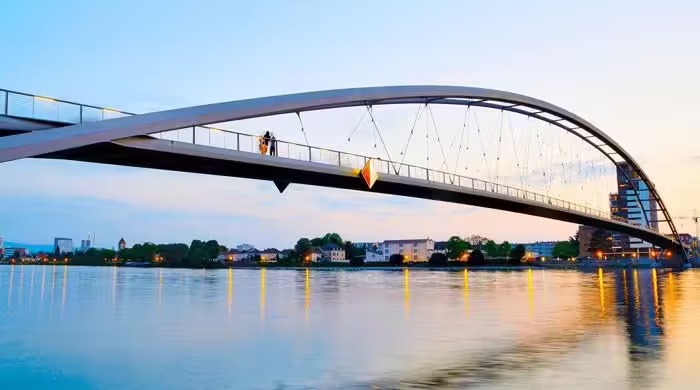The Three Countries Bridge, an architectural gem and award-winning structure, offers a unique opportunity for tourists to experience three countries in a single day. This impressive feat of engineering, costing approximately £86 million, holds the title of the world’s longest single-span bridge. Spanning the Rhine River, it connects the French town of Huningue, Germany’s Weil am Rhein, and lies within the Swiss city of Basel.
Constructed with an eye for both functionality and aesthetic appeal, the Three Countries Bridge stretches 248 meters in total length, with its main span reaching an extraordinary 229.4 meters. Unlike many bridges, it features no central supports in the river, showcasing a remarkable achievement in modern engineering and design. Designed specifically for pedestrians and cyclists, the bridge provides a scenic and uninterrupted crossing of the Rhine.
The visionary behind this engineering marvel is Franco-Austrian architect Dietmar Feichtinger. Inaugurated in 2007, the bridge has since become a symbol of innovative design and a testament to the capabilities of contemporary architecture. Its sleek, unsupported span not only underscores its technical achievement but also offers a smooth, unobstructed path for those traversing the bridge.
Travel enthusiasts who have had the opportunity to walk across the Three Countries Bridge often share their awe-inspiring experiences. The bridge’s design and its function as a cross-border pathway have made it a noteworthy attraction. Visitors are delighted by the chance to traverse from Germany to France and Switzerland all in one day. As one visitor put it, “Great opportunity to walk to Germany, France, and Switzerland in one day.”
Another traveler remarked on the unique experience of crossing the bridge. They noted, “The bridge itself is amazing. That such a large and expensive bridge was built solely for pedestrians and bicycles is enlightening.” This sentiment reflects the bridge’s role in enhancing the quality of life for locals and tourists alike, promoting a healthy and environmentally friendly mode of transport.
The bridge offers not just a practical route but also a visual and cultural experience. On the German side, visitors encounter a highly industrialized area characterized by its large port facilities. This contrasts sharply with the vibrant and multicultural atmosphere of the Swiss and French sides, which are adorned with colorful decorations and offer a more relaxed ambiance.
The Three Countries Bridge stands as more than just a functional structure; it embodies the spirit of international cooperation and modern design. Its construction has facilitated greater interaction between the three bordering countries, enhancing cross-border relations and tourism. By offering a pedestrian and cyclist-friendly crossing, the bridge encourages eco-friendly transportation and provides a picturesque route that enhances the experience of those traversing the Rhine.
The acclaim received by the Three Countries Bridge is a reflection of its significant impact on the region. It is celebrated not only for its engineering prowess but also for its role in fostering cultural exchange and providing a unique travel experience. As the world’s longest single-span bridge, it continues to attract visitors from around the globe who are eager to witness and enjoy its remarkable design.
In conclusion, the Three Countries Bridge exemplifies the pinnacle of modern engineering and design. It serves as a testament to human ingenuity, offering a seamless and scenic crossing that bridges three nations. Its construction represents a triumph of architectural vision and technical expertise, making it a cherished landmark and a must-visit destination for travelers seeking to explore the rich tapestry of Europe.



